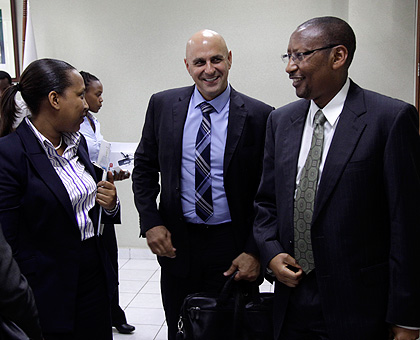Rwanda’s economy will grow at an average real GDP growth of 7.4 per cent each of the next four years, starting this year, but upside factors may bring more growth than the forecasted rates.


Rwanda’s economy will grow at an average real GDP growth of 7.4 per cent each of the next four years, starting this year, but upside factors may bring more growth than the forecasted rates.The forecast was made through a shared assessment between the visiting International Monetary Fund (IMF) team and officials from the Government of Rwanda.The experts said that without considering any new factors that may still play in favour of higher growth than the current forecasts— such as projected increases in foreign direct investments (FDI), a growing tourism industry, expected increase in exports, and potential resumption of aid flows— Rwanda’s economy is guaranteed to grow at 7.4 per cent over the four years given its current performance."Growth over the medium-term is expected to reflect the start of a transition from domestic demand driven, public sector led, aid-reliant growth toward growth that is increasingly driven by net exports, the private sector, including increased FDI inflows, and the government’s own resources,” the IMF’s mission, led by Paulo Drummond, said at the conclusion of its review trip to the country yesterday.The delegation noted that even if Rwanda’s economic growth slowed to 5.9 percent during the first half of 2013 as the government adjusted to a shortfall in donor budget support, improvements in terms of trade, greater exchange rate flexibility, and a drawdown of foreign reserves helped mitigate the economic impact of lower aid flows."Looking ahead, the macroeconomic outlook points to a pick-up in growth in the second half of 2013 as domestic demand recovers with the resumption of aid flows,” the team said in a statement.The IMF, in consultation with government economists haa projected that economic growth for the year 2013 will be at 6.6 per cent, then 7.5 per cent in 2014, 7.6 per cent in 2015, and 8 per cent in 2016.The projections essentially mean that the government’s plan to attain 11.5 per cent growth look unachievable.Conservative estimatesBut the Permanent Secretary and Secretary to the Treasury, Pichette Sayinzoga Kampeta, said the government’s 11.5 growth ambition remains feasible.She cited plans outlined in the country’s second Economic Development and Poverty Reduction Strategy (EDPRS2) among the upside factors that may lead to the realisation of the set economic growth target.Kampeta said that she hoped Rwanda’s economy will grow beyond the 7.4 per cent projection, adding that IMF’s estimates are always "conservative” to help countries maintain prudent monetary policies."There are large public investments that will help us reach where we want to be,” she said.At the cost of about Rwf10 trillion over the next five years, the EDPRS 2 is planned for implementation between 2013 and 2018 and is expected to deliver the country to a middle income status.The economy is set to grow at an average 11.5 per cent during EDPRS 2 implementation and the country’s GDP per capita is projected to increase from the current $644 to $1,240 by the year 2020.Through EDPRS 2, Rwanda looks to make the private sector the main driver of the economy by taking advantage of improved infrastructure, continued political stability, and good governance.Rwanda, which is no longer eligible for IMF’s financial assistance because it has maintained a stable and sustainable macroeconomic position, has requested and obtained services of the Fund’s Policy Support Instrument (PSI).Through its PSI programme, the IMF reviews economic policies of client countries and advises them on how to boost their public sector management, strengthen their financial sectors, and build up their social safety nets.


